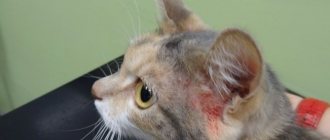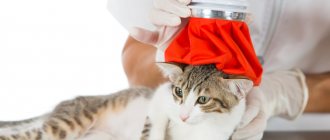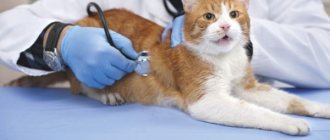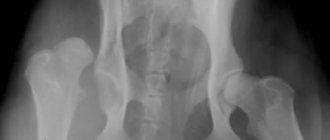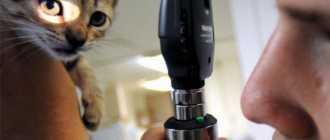Edema and edema are different
Swelling of cat limbs is many-sided and varied, as are the causes that cause them. A cat's paws may swell:
- in a separate relatively small area - with the so-called localized (local or limited, otherwise local) edema;
- over a large area or over the entire surface of the limb - with generalized (or general) edema.
Often the swelling occurs on one paw of the animal (asymmetrical/asymmetrical edema), less often - on two at once (symmetrical edema).
Photo gallery: types of paw edema in cats
Localized swelling occurs in a relatively small, localized area of the cat's paw
Generalized edema covers a significant area of the animal's limb
Symmetrical swelling appears on both legs of the pet at once
Moreover, in most cases, just by the appearance and location of the swollen areas, one can assume what caused their appearance. Moreover, swelling of the paws characteristically affects the behavior of the animal and is often accompanied by additional specific symptoms.
Calm, only calm: we observe and inspect
The first thing to do if your furry dog has a swollen paw is to observe his behavior. Don't panic and remember: in the process of monitoring your pet, you should get all the useful information possible. It is important for you to understand:
- whether the animal is in pain;
- is he afraid to lean on his swollen paw?
- Is your pet limping?
- has the cat become less mobile?
- whether he experiences atypical stiffness in movements;
- Is the animal bothered by itching?
At the next stage, you need to carefully and carefully examine the sore paw, and then the entire pet. This will reveal additional symptoms:
- the presence of open wounds and suppuration in the area of edema;
- changes in skin color in swollen areas (redness, paleness, or blueness);
- local temperature change;
- the appearance of peeling, dandruff, unpleasant odor;
- increased salivation and watery eyes of the animal;
- soreness in areas adjacent to the swollen body.
Peeling skin on a swollen area of a cat's paw is an additional symptom that should not be ignored.
It is important to remember that when conducting such an examination there are no trifles: if you contact a specialist, any deviation from the norm you notice (even the most insignificant) can help in making the correct diagnosis.
Your further actions will directly depend on the results obtained from observing and examining the cat.
About causes and consequences: what to do next
What can be discovered when examining a swollen cat's paw, what possible cause would the identified symptoms correspond to, and how can you help your furry friend?
Table: possible symptoms, causes and treatment for swelling of the cat’s paws
| Results of observations of the cat | Paw examination results | Additional symptoms | Possible cause of swelling | What to do |
| The animal is in pain and does not step on its paw | Mechanical damage to a limb (paw is broken, bitten, cut, dislocated, etc.) |
| Injury |
|
| The animal is in severe pain and drags its paw | General asymmetric edema, no mechanical damage |
| Disease or pathology of blood vessels, thrombosis, heart disease |
|
| The animal experiences acute pain that turns into itching | General or local asymmetric edema, no mechanical damage |
| Insect bite (wasp, bee) |
|
| The animal is lethargic and in severe pain | General asymmetric edema, no mechanical damage |
| Lymphadenitis | Seek help from a specialist: treatment should be aimed at combating the cause that caused the inflammation of the lymph node; Only a professional can determine this reason with the help of special studies. |
| The animal does not experience pain (or almost no pain), but suffers from itching | General asymmetric or symmetrical edema, no mechanical damage |
| Allergic reaction |
|
| The animal has a limp and moves stiffly | Local asymmetric edema, no mechanical damage |
| Joint disease (arthrosis, arthritis) | Seek help from a specialist: the doctor will prescribe a course of antibiotics, a suitable painkiller (if necessary) and select the correct dosage of special nutritional supplements - glucosamine and chondroitin. |
| The animal does not experience pain or visible discomfort | General symmetrical edema |
| Disease of the internal organs (most often the heart or kidneys) | Contact a specialist for a diagnosis and treatment. |
| The animal is not in pain, but has become inactive | General asymmetric edema | The paw has greatly increased in size | Mammary cancer | Contact a specialist for a diagnosis and treatment (in most cases, surgery). |
| The animal is not in pain, but has become passive, may cough and refuse food | Local asymmetric edema |
| Mycosis (fungal infection) |
|
| The animal does not experience pain or visible discomfort | Local symmetrical or asymmetrical swelling of the paw pad |
| Plasmacytic pododermatitis | Seek help from a specialist: he will conduct the necessary research and prescribe antibacterial (if necessary) and hormonal therapy. |
| The animal is limping or dragging its paw, its gait has changed | Local asymmetric edema |
| Abscess (purulent infection) | Seek help from a specialist: he will open the abscess, wash the wound with a disinfectant solution, remove dead tissue, stitch the wound, provide the necessary drainage and prescribe a course of antibiotics. |
Thus, if a cat’s paw is swollen, the owner of the animal should not rely solely on his own knowledge and skills: in this case, the help of a veterinarian is necessary. Too serious reasons can be hidden even behind minor swelling; the risk to the animal’s health is too great. After all, even a simple wasp sting in exceptional cases can cause anaphylactic shock. So a visit to a specialist is not too high a price to pay for the well-being of your pet.
And under no circumstances should you squeeze out an abscess while trying to rid your cat of an abscess on your own: manipulations carried out unprofessionally and in unsterile conditions can cause sepsis (blood poisoning).
Only a specialist can open an abscess and remove pus from it without endangering the health of the animal.
How to treat if a cat has a swollen paw
When a cat's paw is swollen, it is necessary to find the cause of this pathological phenomenon. Swelling of the paws does not appear on its own, and therefore it is important to provide the animal with the necessary help. The paw swells due to the accumulation of pus, blood or lymph in the intercellular space of its tissues. This phenomenon is caused by diseases or mechanical injuries. If a cat has mechanical damage as a result of a cut, bite, embedded splinter, dislocation or fracture, it is necessary to fix the paw and apply cold. Subsequent actions must be entrusted to a specialist. The veterinarian will determine the cause of the pathology visually or using instrumental studies (X-rays, etc.).
The specialist will straighten the dislocation, apply stitches, bandage it, and prescribe antibiotics. Further actions of the owner are aimed at fulfilling the doctor’s orders.
In some cases, an allergic reaction develops to an insect bite. Only one paw is affected, mainly the front one, swelling develops at the site of the bite, and the local temperature rises. If the pathological symptom does not go away within a few hours, veterinary attention will be required. The veterinarian will administer an antihistamine and the swelling will subside.
Arthritis develops mainly in older pets. The reason is a metabolic disorder due to an unbalanced diet. Obesity and chronic diseases develop. One or both hip joints are swollen, painful, hot, and the skin is tense.
The treatment is long-term, complex, and develops in the following areas:
- drug therapy using anti-inflammatory drugs and antibiotics;
- therapeutic diet using ready-made food for cats with joint diseases;
- physiotherapy.
One of the pathological symptoms of heart, liver, and kidney failure is symmetrical swelling of the paws. They suffer. mainly older pets. The disease is incurable. Symptomatic treatment allows you to maintain your pet’s well-being at a satisfactory level.
Lymphadenitis is inflammation of the lymph nodes. Develops as a complication of an infectious disease. The lymph nodes are enlarged and can be detected by palpation. The swelling extends only to the front legs and is accompanied by lameness. If the underlying disease is treated, the lymph nodes will shrink and the swelling will subside.
Most often, cancer affects the mammary glands of an older cat. The swelling extends to the hind legs. Animals whose owners abuse hormonal contraceptives become ill. Treatment is symptomatic, supportive, the prognosis is unfavorable.
Why is it important to find “your” doctor?
Unfortunately, sometimes the cause of swelling of a cat's paw can be a completely ordinary visit to the veterinarian. The first time I encountered such a situation was when my friend was preparing her Sphynx to move to a distant country. By all indications, the cat was absolutely healthy, but the rules required some kind of special blood test. At the veterinary clinic, blood from the vein was taken for analysis without any problems and a pressure bandage was applied to the injured paw to prevent the formation of a hematoma. Everything was done according to the rules, but they forgot to warn the owner that the bandage needed to be removed in about an hour. And my conscientious friend, deciding that it was better to be safe than sorry, left her paw wrapped until the morning (it was in the evening). And early in the morning it turned out that the long-suffering cat’s limb was twice as thick as it was the day before. Fortunately, nothing irreparable happened: it did not lead to tissue necrosis, the paw remained warm and retained sensitivity. So periodic massage and a loose bandage of alcohol-soaked gauze (recommended by another veterinarian) reduced the swelling by lunchtime. The second case directly affected my pet: during the drip administration of vitamins, a poorly secured catheter moved, and the drug went under the skin (instead of a vein). The paw was swollen, any touch to it caused pain, the baby refused to eat. A repeat visit to the veterinarian and a tight bandage with magnesium sulfate applied for an hour and a half corrected the situation. And this time, fortunately, there were also no serious consequences (in the form of an abscess, for example). As it turns out, such cases happen periodically. What can you do: cats are far from the calmest and most obedient patients. However, whatever you say, the doctor’s qualifications also play an important role. Therefore, do not be lazy to make inquiries and find a truly good specialist for your pet (if you value his health, of course). Believe me: a visit to the veterinary clinic closest to your home is not always the right step.
First aid for a swollen paw
When it is noticed that a cat's paw is swollen, it should be examined immediately. If it is discovered that the disorder is due to her being injured, then you can try to avoid visiting the veterinary clinic, but only if there is no severe suppuration. The algorithm of actions for treatment should be as follows:
- washing the wound with hydrogen peroxide or chlorhexidine;
- treating the skin around the wound with iodine - if the limb is particularly swollen, then iodine can be dangerous and is replaced with alcohol;
- applying a bandage to the wound with a mixture of ichthyol ointment and levomekol ointment.
We invite you to familiarize yourself with Peterbald (52 photos): features of cats of the Petersburg Sphynx breed, a description of the character of cats and kittens. How many years do they live?
A cat's paws can become swollen for many reasons, and therefore you should immediately take the animal to a veterinarian. Today, finding an animal clinic near your home is not difficult. You need to help your pets as soon as they develop health problems.
When a cat's paw is swollen and he is limping, you need to know exactly what to do in order to quickly provide first aid to the animal. The pet is examined for wounds and bruises. If you have them, you can treat them at home yourself. In severe cases, it is better to contact a veterinary clinic. Standard care for wounds and minor blisters includes:
- rinsing with chlorhexidine and hydrogen peroxide;
- treating the skin around the injury with iodine or alcohol;
- applying a bandage soaked in levomekol or ichthyol ointment.
Since limbs can swell for many reasons, do not put off visiting the veterinarian. It is not so difficult to find a suitable specialist; it is important that the examination is carried out on time and treatment is prescribed as soon as possible.
Cats also get plaster casts.
